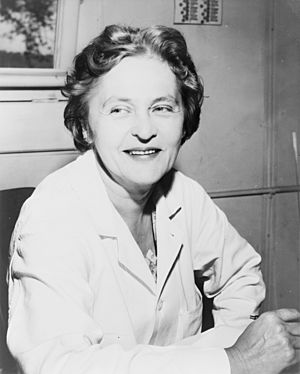Mária Telkes facts for kids
Quick facts for kids
Mária Telkes
|
|
|---|---|

Telkes in 1956
|
|
| Born | 12 December 1900 |
| Died | 2 December 1995 (aged 94) Budapest, Hungary
|
| Known for | Thermoelectricity |
| Awards | National Inventors Hall of Fame |
| Scientific career | |
| Fields | Physics |
| Institutions | Cleveland Clinic Foundation, Westinghouse, Massachusetts Institute of Technology, New York University, University of Delaware |
Mária Telkes (December 12, 1900 – December 2, 1995) was a smart Hungarian-American scientist and inventor. She was often called The Sun Queen because she worked on amazing ways to use solar energy.
She moved to the United States in 1925 and became an American citizen in 1937. Soon after, she started working at the Massachusetts Institute of Technology (MIT) in 1939. Her goal was to find practical ways to use the sun's power.
During World War II, Mária Telkes invented a special device that used the sun to turn salty water into fresh, clean water. This invention saved the lives of many soldiers and sailors. After the war, she became a professor at MIT.
In the 1940s, she and architect Eleanor Raymond built one of the first houses heated by the sun. They also created a solar oven that could be used by people around the world, even by children. Mária Telkes received many awards for her work and held more than 20 patents.
Contents
Early Life and School
Mária Telkes was born in Budapest, Hungary, in 1900. She went to elementary and high school there. She later studied at the Eötvös Loránd University, where she earned her first degree in physical chemistry in 1920. She then got her PhD in 1924.
Career and Inventions
In 1924, Mária Telkes moved to the United States. She started working at the Cleveland Clinic Foundation. There, she researched the energy produced by living things. She even helped invent a device that could record brain waves.
After that, Telkes worked as a physicist at Westinghouse. She helped create special metal mixes for devices called thermocouples. These devices can turn heat directly into electricity.
In 1939, she joined the Massachusetts Institute of Technology (MIT) to work on their new solar energy program. She stayed there until 1953.
Making Fresh Water from Sun
During World War II, the U.S. government asked Mária Telkes for her help. She used her skills to develop a solar-powered machine that could make fresh water from salty water. She finished a first version in 1942.
This invention became very famous because it helped soldiers get clean drinking water in tough places. It also helped solve water problems in the United States Virgin Islands.
Storing Sun's Heat for Homes
Mária Telkes believed that storing solar heat was the biggest challenge for building houses heated by the sun. She specialized in materials that could absorb or release heat when they changed from a solid to a liquid. She hoped to use materials like Glauber's salt to store heat in solar heating systems.
In 1946, her team tried to use Glauber’s salt in their second solar house design. Even though there were some challenges with the material, Mária Telkes kept working on new ideas for solar energy.
The Dover Sun House
In 1948, Telkes started working on the Dover Sun House with architect Eleanor Raymond. A kind person named Amelia Peabody paid for the project. The house used Glauber's salt to store heat. The salt would melt in the sun, holding the heat, and then release it as it cooled and turned solid again.
Here is how the system worked:
- Sunlight passed through glass windows, heating the air inside.
- This warm air moved through a metal sheet into another air space.
- Fans then blew the warm air to storage areas filled with Glauber's salt.
- These storage areas were built into the walls, heating the house as the salt cooled down.
For the first two years, the house worked very well and got a lot of attention. Popular Science magazine even said it might be as important as the atom bomb! However, after three winters, the Glauber’s salt started to have problems. The owners eventually replaced the solar heating system with a regular oil furnace.
Solar-Powered Oven
In 1953, Mária Telkes began working at the New York University College of Engineering. She continued her research on solar energy there.
She received money from the Ford Foundation to create a solar-powered oven. This oven was designed to help people around the world who did not have modern cooking technology. The oven needed to reach 350° Fahrenheit (175° Celsius) and be easy for anyone to use.
Mária Telkes also worked for several companies. She helped develop materials for use in extreme places, like space, for projects such as the Apollo mission. In 1969, she joined the Institute of Energy Conversion at the University of Delaware. She studied how to make photovoltaic cells, which turn sunlight directly into electricity.
In 1971, she helped build the first house that could create both heat and electricity from the sun. In 1981, she helped the U.S. Department of Energy build the Carlisle House in Carlisle, Massachusetts, which was the first home fully powered by the sun.
Awards and Recognition
Mária Telkes received many awards for her important work:
- 1945 – Certificate of Merit for her Desalination Unit
- 1952 – First ever Society of Women Engineers Achievement Award
- 1977 – Charles Greeley Abbot Award from the American Solar Energy Society
- 2012 – Inducted into the National Inventors Hall of Fame
See also
 In Spanish: Mária Telkes para niños
In Spanish: Mária Telkes para niños

